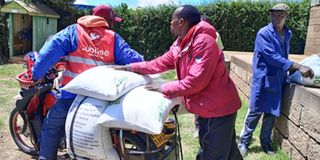17,000 Kirinyaga farmers register for subsidised fertiliser

Farmers load subsidized fertilizer on a motorbike at Kiganjo NCPB depot in Nyeri County on September 27, 2022. Some 17,000 growers have registered to benefit from supply of inputs in Kirinyaga County.
Some 17,000 farmers in Kirinyaga County have registered to receive subsidised fertiliser.
The growers are upbeat the cheaper inputs will boost their yields.
The farmers are in the National Cereals and Produce Board (NCPB) database, with the numbers expected to rise as registration continues.
Adequate farm inputs
Governor Anne Waiguru said the county was working well with the national government to ensure farmers receive adequate farm inputs.
She said her administration will support farmers to maximise their agricultural production.
“To promote other areas of agriculture, we are at the forefront of lobbying for subsidised farm inputs to reduce the cost of production and enable farmers to get better returns," she said in Kerugoya.
Farmers were counting on the fertilisers to get better harvests this season, she added.
Mr Albert Njeru, from Njukii-ini ward, thanked the county government for making it easier for farmers to get the fertilisers by taking them to wards.
Reducing the price of DAP fertiliser from Sh6,500 to Sh3,500 will enable farmers to get better harvests, he said.
Another farmer, Ms Magdaline Maina, said subsidised fertiliser will enable her to expand land under cultivation and increase her harvests and income.
The farmers also thanked President William Ruto for fulfilling his pre-election pledge on subsidised fertilisers, saying smallholder farmers are pivotal in stimulating economic growth at the grassroots.
Registration in wards is underway. Farmers must show they own land, its size and the bags they need.
Registered farmers can also walk into NCPB depots and personally collect the fertilisers.
Kirinyaga is a predominantly agricultural county, with 52,890 hectares under subsistence farming.
High costs of farm inputs such as fertilisers had discouraged farmers from crop farming, but with the subsidised input, they are expected to increase production.





